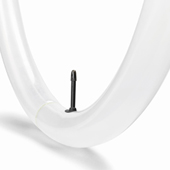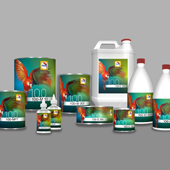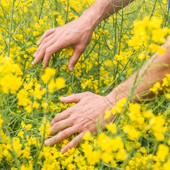Innovations in the Segments – Examples
Research and development expenses by segment 2020
Chemicals
BASF’s Styrodur® Hybrid is the next generation of the green insulation boards made from extruded polystyrene for customers in the construction industry. The hybrid version has vertical grooves on one side to bond better with the concrete. The simpler and cleaner processing leads to considerable time and cost savings in construction, for example by eliminating the need for full-surface adhesion. These advantages are in addition to the general benefits offered by Styrodur, such as high compressive strength, low moisture absorption, and excellent thermal insulation properties, which play a significant role in reducing CO2 emissions and cutting heating costs.

Styrodur® Hybrid
- Insulation board with excellent thermal insulation properties
- Reduces CO2 emissions and cuts heating costs
In 2020, BASF launched OASE® sulfexx™ – a new, energy-efficient amine gas treatment technology developed in cooperation with ExxonMobil Catalysts and Licensing LLC. The new OASE® sulfexx™ branded technology helps refiners and gas processors to meet their sulfur removal targets while reducing their carbon footprint. It ensures the highly selective removal of hydrogen sulfide (H2S) from gas streams while minimizing carbon dioxide (CO2) co-absorption. This provides a competitive advantage by increasing plant capacity and lowering investment and production costs.

OASE® sulfexx™
- Energy-efficient amine gas treatment technology
- Highly selective removal of hydrogen sulfide (H2S)
Materials

Elastollan®
- New generation of recyclable bicycle tubes based on Elastollan®
- Around 40% lighter than alternatives on the market
Together with our partner Schwalbe, we have developed a new generation of bicycle tubes based on the thermoplastic polyurethane (TPU) Elastollan®. The new Aerothan bicycle tube offers exceptional performance, puncture resistance and stable handling thanks to the special mechanical properties of Elastollan®. It is around 40% lighter than the established alternatives on the market, is easy to assemble and has a small packing size. Another advantage of the Aerothan bicycle tubes is that they are recyclable. They are made entirely of thermoplastic polyurethane and can be returned to the manufacturer, easily and free of charge, via the tube recycling program. The material of the old tubes is processed and then reused as sealing or insulating material.
BASF’s new additive for the asphalt industry, B2Last®, has been designed for sustainable road construction. It extends pavement life while cutting CO2 emissions along the production chain. B2Last® meets additional health and safety requirements by enabling asphalt to be produced and processed at significantly lower process temperatures. The innovative additive enables faster completion times and reduces emissions, improving the carbon footprint and making roads more durable.
Industrial Solutions
Demand for biocide-free products with high scrub resistance and low levels of volatile organic compounds (VOC) has become a driving force in the European market for water-based interior paints in recent years. For 20 years, the market has been dominated by ethylene vinyl acetate dispersions, which cannot be used in biocide-free paints. BASF offers an attractive alternative: Acronal® 6292. Acronal® 6292 is a styrene-acrylate binder that makes it possible to produce environmentally friendly, biocide-free and low-VOC paints. This has enabled BASF to successfully open up a new market segment that addresses customers’ requirements around avoiding allergic reactions while maintaining the same product properties.
BASF and IntelliSense.io, a leading industrial artificial intelligence (AI) company, have combined their expertise in mineral processing, ore beneficiation chemistry and industrial AI technology. The joint offering is called the BASF Intelligent Mine powered by IntelliSense.io and delivers AI solutions embedded with BASF’s mineral processing and chemical expertise. The solution helps customers to make their mine operations more efficient, sustainable and safe, while offering a real-time decision-making platform. Each mining process, such as grinding, thickening, flotation and pumping, is supported by an Optimization as a Service application that predicts and simulates future performance, generating process-specific recommendations for optimization. This enables customers to realize efficiency gains across the entire value chain.
Surface Technologies
The Fourtune™ FCC catalyst is the latest addition to the refining catalysts portfolio. It is based on BASF’s Multiple Framework Topology technology. Fourtune has been optimized to deliver superior butylene over propylene selectivity while maintaining catalyst activity and performance. The technology provides an answer to the increased demand for octane since today’s tighter sulfur regulations often require post treatment on the gasoline stream. This can negatively impact the octane pool. The higher butylene selectivity enables refineries to optimize gasoline octane and with it, their profitability.

Glasurit® 100 Line and R-M® AGILIS
- Waterborne basecoat technology
- Reduces volatile organic compounds (VOC)
With Glasurit® 100 Line and R-M® AGILIS, BASF has introduced the most advanced waterborne basecoat technology for refinish coatings, offering outstanding efficiency and environmental advantages. The focus in product development was on sustainability, with the result that VOC levels are consistently below 250g/l. This is the lowest VOC level on the market, making the new product line the eco-friendliest automotive refinish coatings available. The innovative formulation optimizes the processing properties for fast and efficient application, enabling customers to cut process times by up to 35%. Another 20% can be saved from the reduction in material consumption. This allows body shops to reduce their CO2 emissions through faster application and shorter drying cycles. At the same time, they can increase profitability and improve their environmental footprint.
Nutrition & Care
Together with other quality ingredients from the BASF Home Care and Industrial & Institutional Cleaning portfolio, the cellulase Lavergy® C Bright 100 L harnesses the combined power of different technologies to achieve a sustainable, performance-differentiated solution. Lavergy® C Bright 100 L can be combined with other selective ingredients to prevent fabrics from graying. Whether whites or colors, cotton or synthetic fibers – clothes look like new even after multiple washes. Lavergy® C Bright 100 L also meets the criteria for various ecolabeling systems including EU Ecolabel and Blue Angel. Excellent cleaning performance and good environmental compatibility, as well as suitability for use with many types of fabric are the hallmarks of BASF’s one-fits-all solution.
BASF has launched the new fragrance Isobionics® Santalol, an alternative to sandalwood oil. Isobionics® Santalol is produced on a biotechnological basis from renewable raw materials and is 100% free of endangered sandalwood. Our fermentation technology ensures consistent high quality, effective production and year-round availability. Isobionics® Santalol resembles the floral heart of sandalwood oil and is particularly suitable for use in perfumes and exclusive personal care products thanks to its woody odor profile.
Agricultural Solutions
We leverage the potential of digitalization in agriculture to help farmers grow their business profitably and reduce their environmental footprint. Launched in 2020, the new outcome-based business model xarvio® HEALTHY FIELDS provides a tailored, optimized field and season-specific crop protection strategy. By measuring and classifying externally induced plant stress, automatically defining buffer zones and recording biodiversity on and off arable land, it guarantees plant health and enables farmers to achieve agreed yield forecasts. This way, we respond to modern farming challenges, requirements by society and political action plans and contribute to more sustainable farming.
In 2020, xarvio® HEALTHY FIELDS received the Crop Science Award, one of the most important and renowned awards in the agricultural industry worldwide, for the “Best Innovation in Digital Farming Technology.”
Wheat is one of the most produced crops in the world and demand continues to increase based on the growing world population. Our agricultural innovations for wheat production contribute to food security, which will help to reach the U.N. Sustainable Development Goals (SDGs). Our R&D pipeline comprises solutions that help farmers to achieve better yield – balancing the needs of the environment, society and agriculture.
In 2020, we received the first registration worldwide for the new herbicide active ingredient Tirexor®. It will give wheat growers in Australia more choice for effective weed control to combat resistance and enable climate-smart, no-till farming. Further dossier submissions in other countries across Asia, South and North America are planned.
Our recently launched fungicide Revysol® will also play a crucial role in future resistance management in wheat, helping growers to better protect their crops, manage resistances and increase their yield in a sustainable way.

Hybrid wheat
- Improved harvest quality and stability
- Securing high yield in the long term
With market entry expected by mid-decade, we will introduce hybrid wheat,1 supporting the nutritional needs of a growing world population. Hybrid wheat will bring much needed innovation to wheat production and start a journey to transform this crop for long-term success to deliver high performance in yield, quality and stability to meet the agronomic needs of farmers and the value chain in North America and Europe. The hybrid approach will give breeders new opportunities to adapt and improve plant characteristics and will play an important role in addressing the environmental challenges of the future.
1 R&D expenses reported under Other

InVigor® technologies for hybrid canola
- For pod shatter reduction and resistance to plant diseases
- More flexibility at harvest
BASF’s InVigor® hybrid canola pod shatter reduction and clubroot resistant trait technologies help to protect yield potential from clubroot and deliver more flexibility for growers at harvest. In addition, we launched the 300 series of InVigor hybrid canola for the 2020 growing season, featuring three new hybrids that offer growers improvements in yield, pod shatter reduction protection, or clubroot resistance.
Various innovative crop protection products, such as the recently acquired L-glufosinate ammonium herbicide technology and seed treatment in combination with digital products, help farmers to manage weeds, pests and diseases and also enable higher yield.
BASF joined the AGROS program in 2020, a collaboration between the Netherlands-based Wageningen University & Research and 26 private partners looking into autonomous vegetable growing. The aim is to make best use of technology and accelerate innovation in order to meet the growing demand for food, while preserving natural resources. We are focusing even more strongly on the needs of our consumers with the joint development of a connected, data-driven, automated and sustainable production system. Further research relates to optimized cultivation methods for growing cucumbers based on sensors, plant physiology and artificial intelligence.